#Difference between meteoroid and meteorite
Explore tagged Tumblr posts
Text

Though he tried hard to recall what he had learned about space rocks back in middle school, local man Jason Nieto reportedly forgot the difference between meteoroids and meteorites Thursday, struggling to describe what had just killed his dog. “God, I always forgot which one is the kind that actually hits the ground, if that’s even the difference, so I’m not sure what just crushed Churro,” said Nieto, explaining that the meteorite or meteoroid—or maybe asteroid, if that was a category including all of them—came streaking out of the clouds while he was walking his Pomeranian in the park. Full Story
693 notes
·
View notes
Text
Do you know the difference between the meteoroid, meteor and meteorite?
A meteoroid is a small object that ranges in size from a grain of salt to a few meters. It is usually composed of rocks, metals or mixtures of both. It is found in space orbiting the Sun or other celestial bodies.
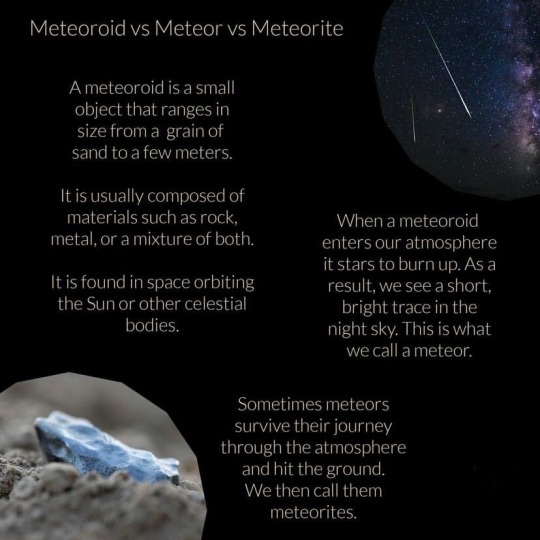
#meteorite#meteor#meteroid#astronomy#nasa#astronomers#universe#astrophotography#nasa photos#astrophysics#outer space#nasawebb#hubble space telescope#i love astronomy#astronomy facts#astronauts#planetary science#planetary nebula#nebula#space travel#international space station#nasaastronaut#nasa science#nasa picture of the day#nasa jpl#space science#space exploration#space#james webb space telescope#science facts
69 notes
·
View notes
Text

Friday, March 7, 2025
Since I had an exam today, I did not post yesterday. I needed that time to study some more, and it paid off. One whole section was based on To Kill a Mockingbird, which I recently finished reading, one section was vocabulary, and the middle section was short answer about some literary movements and figures.
Today was also the last day of the third quarter grading period since the curriculum I use goes in quarters rather than semesters for full year courses. I have an A in every course. Like I say every time I share overall grades, my curriculum is so easy to get an A in as long as one does the work. There are so many catch up and extra credit activities that one can choose to do to increase their grade and understand the material better. Plus, I write a lot things down that I know will be useful for tests, and writing it down helps me remember it better. I find that if I'm only reading, I tend to skim instead of reading everything word for word, which sometimes means I miss things, especially in academic and historical texts which we read a lot of.
I want to give an update now while I'm thinking about it, and I'll type of a reminder next week too, but the week after next is spring break in our area, and I will be traveling out of the country that week with the seniors from my Girl Scout troop. It's our senior trip since we'll bridge this year. That being said, during that time, I will have my phone for safety reasons, but I will not be posting nor checking in more than likely.🦄
Tasks Completed:
Algebra 2 - Reviewed distance and midpoint formulas + read about conic sections + reviewed standard equations of circle + practice
American Literature - Quarter 3 exam (30/30)
Spanish 3 - Practiced the subjunctive
Bible 2 - Read Psalms 35 and 36
Early American History - Read about The Oregon Country
Earth Science with Lab - Watched video on meteors, meteoroids, and meteorites + read about comets, asteroids, and meteors
P.E./Health 2 - Read a health article about the worldwide forecast of obesity in children
Art Appreciation - Compared paintings by Chardin altogether to spot differences between the date ranges + took notes on how to recognize his paintings, style, and philosophy
Khan Academy - Completed U.S. History Unit 4: Lesson 2.10
Duolingo - Studied for approximately 15 minutes (Spanish + French + Chinese) + completed daily quests
Piano - Practiced for two hours
Reading - Read pages 6-36 of Mansfield Park by Jane Austen
Chores - None today
Activities of the Day:
Personal Bible Study (Philippians 4:6-7)
6-Week Devotional Journey (Matthew 11:28-30)
Group Bible Study (Numbers 28-30)
Volunteered 3 hours at the mission
Ballet
Variations
Journal/Mindfulness
#study blog#study inspiration#study motivation#studyblr#studyblr community#study community#homeschool#homeschooling#study-with-aura
6 notes
·
View notes
Note
When is your birthday?
It's on June 30, Oh. Speaking of June 30 did you know that day is Meteor Day? Meteors are often called falling stars, or shooting stars. Oh funfacts about meteors! When a Meteor Shower happens, It's when the Earth passes through the trail of debris left by a comet or an asteroid. Another funfact about it, It has 3 names. A "meteoroid" is when it's still in outer space A "meteor" is when it is the Earth's atmosphere A "meteorite" is when it lands on Earth Another basic funfact about Meteors is that they are made out of basic metals and rocks! Like iron, nickel, and obviously stone. If you try finding a difference between a meteorite and a rock it's hard to find the difference since it has a lot of similarities, and on rare occasions the meteorite may contain gold and platinum. Oh and SOME meteorites can bring materials that can't be found on earth like neodymium and praseodymium which are rare elements that are necessary to make magnets. OH AND, Meteors can contain gems and other rare materials! ..I think that's enough talking about meteors!
2 notes
·
View notes
Text
[ID: a Ghost Trick screenshot of Yomiel getting hit with the meteorite fragment, captioned with an Onion article that's been slightly edited to read: "Man Forgetting Difference between Meteoroid, Meteorite Struggles To Describe What Just Killed Him." End ID.]
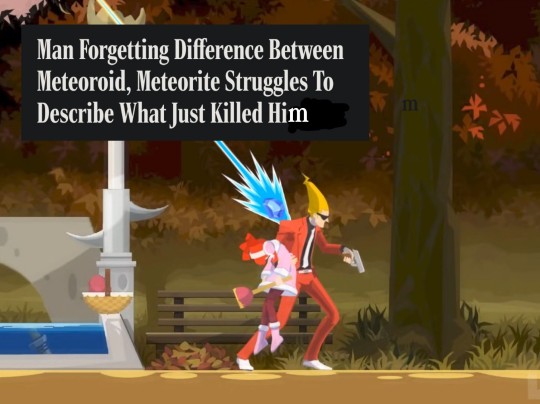
“God, I always forget which one is the kind that actually hits the ground, if that’s even the difference.”
(the original onion article is even MORE ghost trick-coded if you can believe it)
#op please consider editing this id into the original for accessibility! no credit needed; your own edits welcome#LMAO GOD#ghost trick#ghost trick spoilers
145 notes
·
View notes
Text
For about 4 billion years
For about 4 billion years, the earth experienced an environment similar to the acidic era. Then what is the reason for the sudden formation of oceans on earth for the last 4 billion years?
After the Earth's surface had cooled to a temperature below the boiling point of water, rain began to fall—and continued to fall for centuries. As the water drained into the great hollows in the Earth's surface, the primeval ocean came into existence. The forces of gravity prevented the water from leaving the planet.16 Jun 2024
Origin of water on Earth
Wikipedia
https://en.wikipedia.org › wiki › Origin_of_water_on_...
what is the reason for the sudden formation of oceans on earth for the last 4 billion years? from en.wikipedia.org
Extraplanetary sources
Water has a much lower condensation temperature than other materials that compose the terrestrial planets in the Solar System, such as iron and silicates. The region of the protoplanetary disk closest to the Sun was very hot early in the history of the Solar System, and it is not feasible that oceans of water condensed with the Earth as it formed. Further from the young Sun where temperatures were lower, water could condense and form icy planetesimals. The boundary of the region where ice could form in the early Solar System is known as the frost line (or snow line), and is located in the modern asteroid belt, between about 2.7 and 3.1 astronomical units (AU) from the Sun.[23][24] It is therefore necessary that objects forming beyond the frost line–such as comets, trans-Neptunian objects, and water-rich meteoroids (protoplanets)–delivered water to Earth. However, the timing of this delivery is still in question.
One hypothesis claims that Earth accreted (gradually grew by accumulation of) icy planetesimals about 4.5 billion years ago, when it was 60 to 90% of its current size.[21] In this scenario, Earth was able to retain water in some form throughout accretion and major impact events. This hypothesis is supported by similarities in the abundance and the isotope ratios of water between the oldest known carbonaceous chondrite meteorites and meteorites from Vesta, both of which originate from the Solar System's asteroid belt.[25][26] It is also supported by studies of osmium isotope ratios, which suggest that a sizeable quantity of water was contained in the material that Earth accreted early on.[27][28] Measurements of the chemical composition of lunar samples collected by the Apollo 15 and 17 missions further support this, and indicate that water was already present on Earth before the Moon was formed.[29]
One problem with this hypothesis is that the noble gas isotope ratios of Earth's atmosphere are different from those of its mantle, which suggests they were formed from different sources.[30][31] To explain this observation, a so-called "late veneer" theory has been proposed in which water was delivered much later in Earth's history, after the Moon-forming impact. However, the current understanding of Earth's formation allows for less than 1% of Earth's material accreting after the Moon formed, implying that the material accreted later must have been very water-rich. Models of early Solar System dynamics have shown that icy asteroids could have been delivered to the inner Solar System (including Earth) during this period if Jupiter migrated closer to the Sun.[32]
Yet a third hypothesis, supported by evidence from molybdenum isotope ratios, suggests that the Earth gained most of its water from the same interplanetary collision that caused the formation of the Moon.[33]
The evidence from 2019 shows that the molybdenum isotopic composition of the Earth's mantle originates from the outer Solar System, likely having brought water to Earth. The explanation is that Theia, the planet said in the giant-impact hypothesis to have collided with Earth 4.5 billion years ago forming the Moon, may have originated in the outer Solar System rather than in the inner Solar System, bringing water and carbon-based materials with it.[33]
Sudden changes on Earth can happen due to the effect of light in the atmosphere
Actually all these reactions are happening due to the speed of light
That is why the most important part of the reaction is the speed of light
Translate Hindi
लगभग 4 अरब वर्ष तक धरती एसिड युग जैसा वातावरण बीताता था
फिर धरती में अचानक महासगर बनने का कारण क्या है पीछले 4 अरब वर्षों तक
पृथ्वी की सतह के पानी के क्वथनांक से नीचे के तापमान तक ठंडा होने के बाद, बारिश होने लगी - और सदियों तक गिरती रही। जैसे-जैसे पानी पृथ्वी की सतह के बड़े गड्ढों में बहता गया, आदिम महासागर अस्तित्व में आया। गुरुत्वाकर्षण की शक्तियों ने पानी को ग्रह से बाहर जाने से रोक दिया।16 जून 2024
पृथ्वी पर पानी की उत्पत्ति
विकिपीडिया
https://en.wikipedia.org › wiki › Origin_of_water_on_...
पिछले 4 अरब वर्षों में पृथ्वी पर अचानक महासागरों के बनने का क्या कारण है? en.wikipedia.org से
अतिरिक्त ग्रहीय स्रोत
पानी का संघनन तापमान सौर मंडल में स्थलीय ग्रहों को बनाने वाली अन्य सामग्रियों, जैसे लोहा और सिलिकेट की तुलना में बहुत कम होता है। सौर मंडल के इतिहास में सूर्य के सबसे निकट प्रोटोप्लेनेटरी डिस्क का क्षेत्र बहुत गर्म था, और यह संभव नहीं है कि पृथ्वी के बनने के साथ ही पानी के महासागर भी संघनित हो गए हों। युवा सूर्य से आगे जहां तापमान कम था, पानी संघनित हो सकता था और बर्फीले ग्रहों का निर्माण कर सकता था। उस क्षेत्र की सीमा जहां प्रारंभिक सौर मंडल में बर्फ बन सकती थी उसे फ्रॉस्ट लाइन (या स्नो लाइन) के रूप में जाना जाता है, और यह आधुनिक क्षुद्रग्रह बेल्ट में सूर्य से लगभग 2.7 और 3.1 खगोल इकाइयों (एयू) के बीच स्थित है।[23][24] इसलिए यह आवश्यक है कि फ्रॉस्ट लाइन से आगे बनने वाली वस्तुएं- जैसे धूमकेतु, ट्रांस-नेप्च्यूनियन ऑब्जेक्ट्स, और पानी से भरपूर उल्कापिंड (प्रोटोप्लेनेट)-पृथ्वी पर पानी पहुंचाएं। हालांकि, इस वितरण का समय अभी भी सवालों के घेरे में है।
एक परिकल्पना का दावा है कि पृथ्वी ने लगभग 4.5 अरब साल पहले बर्फीले ग्रहों को संचित (धीरे-धीरे जमा होकर बड़ा) किया यह परिकल्पना सबसे पुराने ज्ञात कार्बनयुक्त चोंड्राइट उल्कापिंडों और वेस्टा के उल्कापिंडों के बीच पानी की प्रचुरता और आइसोटोप अनुपात में समानताओं द्वारा समर्थित है, जो दोनों सौर मंडल के क्षुद्रग्रह बेल्ट से उत्पन्न होते हैं।[२५][२६] यह ऑस्मियम आइसोटोप अनुपातों के अध्ययनों से भी समर्थित है, जो सुझाव देते हैं कि पृथ्वी द्वारा प्रारंभिक रूप से एकत्रित सामग्री में पानी की एक बड़ी मात्रा निहित थी।[२७][२८] अपोलो १५ और १७ मिशनों द्वारा एकत्र चंद्र नमूनों की रासायनिक संरचना के मापन इसे और समर्थन देते हैं, और संकेत देते हैं कि चंद्रमा के बनने से पहले ही पृथ्वी पर पानी मौजूद था।[२९] इस परिकल्पना के साथ एक समस्या यह है कि पृथ्वी के वायुमंडल के नोबल गैस आइसोटोप अनुपात इसके मेंटल से भिन्न हैं हालांकि, पृथ्वी के निर्माण की वर्तमान समझ चंद्रमा के बनने के बाद पृथ्वी की 1% से भी कम सामग्री के एकत्र होने की अनुमति देती है, जिसका अर्थ है कि बाद में एकत्रित सामग्री में बहुत अधिक पानी रहा होगा। प्रारंभिक सौर मंडल की गतिशीलता के मॉडल ने दिखाया है कि यदि बृहस्पति सूर्य के करीब चला जाता तो इस अवधि के दौरान बर्फीले क्षुद्रग्रह आंतरिक सौर मंडल (पृथ्वी सहित) तक पहुँच सकते थे।[32]
फिर भी एक तीसरी परिकल्पना, जो मोलिब्डेनम आइसोटोप अनुपातों के साक्ष्य द्वारा समर्थित है, यह सुझाव देती है कि पृथ्वी ने अपना अधिकांश पानी उसी अंतरग्रहीय टकराव से प्राप्त किया जिसने चंद्रमा का निर्माण किया।[33]
2019 के साक्ष्य से पता चलता है कि पृथ्वी के मेंटल की मोलिब्डेनम समस्थानिक संरचना बाहरी सौर मंडल से उत्पन्न होती है, जो संभवतः पृथ्वी पर पानी लेकर आई है। व्याख्या यह है कि थिया, वह ग्रह जिसके बारे में विशाल-प्रभाव परिकल्पना में कहा गया था कि 4.5 अरब साल पहले पृथ्वी से टकराकर चंद्रमा बना था, संभवतः आंतरिक सौर मंडल के बजाय बाहरी सौर मंडल में उत्पन्न हुआ था, और अपने साथ पानी और कार्बन-आधारित पदार्थ लाया था।[33]
धरती में ही अचानक बदलाव वातावरण में रोशनी के प्रभाव से ऐसा हो सकता है
असल में यह सारे रिएक्शन असल में रोशनी की गति के कारण हो रहा है
इसलिए ही तो रिएक्शन का सबसे ज्यादा महत्वपूर्ण अंश ही है रोशनी की गति
0 notes
Text
[Scene: Central Perk. The usual gang—Ross, Rachel, Monica, Chandler, Joey, and Phoebe—are seated around their favorite couch. Ross is explaining a recent incident at work.]
Ross: (animatedly) So, there I was, giving this important lecture on paleontology, and right in the middle of my speech, one of my students starts correcting me. Can you believe that? Deference, people, deference!
Monica: (smirking) Oh, Ross, maybe they were just trying to help. You know, improve your...already perfect knowledge.
Chandler: (sarcastically) Yeah, Ross. I mean, it's not like you don't drone on for hours about rocks and bones. They were probably just trying to save their sanity.
Joey: (confused) What's "deference"? Is that like when you refer to something else?
Phoebe: (giggling) No, Joey. Deference is like when you show respect and let someone else take the lead. Like when we all defer to Monica on Thanksgiving...because she threatens us.
Rachel: (laughing) And we all defer to Phoebe when she starts talking about her...unique...viewpoints on life.
Phoebe: (nodding seriously) Exactly. Deference. Like how I defer to my guitar when it wants to play a new song. We have an understanding.
Joey: Oh, I get it now! So, like, when I defer to Chandler to pay for dinner because I forgot my wallet again?
Chandler: (exasperated) Yes, Joey. That's one way to put it. Or you could just remember your wallet for once.
Ross: (sighing) Anyway, the point is, deference is important. It shows respect. And maybe, just maybe, my students could learn a little bit of it.
Monica: (teasingly) Well, Ross, maybe you could learn to be a little more...approachable. You know, like when you're not correcting everyone all the time.
Ross: (defensive) I do not correct everyone all the time!
Rachel: (raising an eyebrow) Really? Remember that time I called it a "dinosaur bone" and you went on a ten-minute lecture about how it's technically a "fossilized remain"?
Chandler: (grinning) Or when Joey said he saw a "meteorite" and you insisted on explaining the difference between a meteor, a meteoroid, and a meteorite?
Phoebe: (nodding) Or that time I was singing "Smelly Cat" and you tried to correct my chord progression?
Joey: (laughing) Yeah, Ross, maybe you need a lesson in deference
0 notes
Text
I'm so grateful that my outer space unit test in science is open book because I'd never be able to remember the difference between meteoroids, meteorites, and meteors
#kit's rambles#those words are practically identical#kinda like geology geometry and geography#they're basically the same I'm sorry
0 notes
Text
Word of the day
Welcome back everyone, today our word is aerolith, meaning a stony meteorite consisting of silicate minerals (quartz, clay, etc).
While not necessarily descriptive, it can be good for establishing character interest and knowledge.
The average person wont know the difference between a meteoroid and meteorite, let alone what an aerolith is, which can demonstrate a character’s understanding of space objects (specifically the kind that fall to Earth).
In lesser cases, it can show a character having a deep understanding of petrology (the study of rocks), as they will likely identify it by the type of mineral.
Overall, while it can be used as a general word to describe a type of meteorite, it’s better suited to show a character’s interest and/or field of study, and how much they understand about it.
#writing#writeblr#writer#writers#writers of tumblr#writers on tumblr#writblr#writerscommunity#writer advice#writing advice#novel writing#writers and poets#writer things
1 note
·
View note
Note
I've heard of asteroids and all the other space rocks, what are the differences between them? What are they made of?
Asteroids, meteoroids, meteors, meteorites, and comets are all remains from the formation of our solar system primarily composed of rock and dust.
Comets- (Frozen Gas, Dust, Rock, Ice) As a comet passes the sun, it’s pulled into orbit where it speeds up. Once they’re near the Sun, they heat up and form a long trail of dust and gas as they orbit the Sun.
Asteroids- (No Air, Rocky) Known to be in the asteroid belt between Mars and Jupiter.
Meteoroids- Smaller objects in space ranging from dust to small asteroids.
Meteors- Also called shooting stars, they are meteoroids that enter Earth’s atmosphere and burn up.
Meteorites- Meteoroids that are successful in entering the Earth’s atmosphere and hitting the ground.


0 notes
Text
What We See In The Stars
An Illustrated Tour of the Night Sky
By Kelsey Oseid

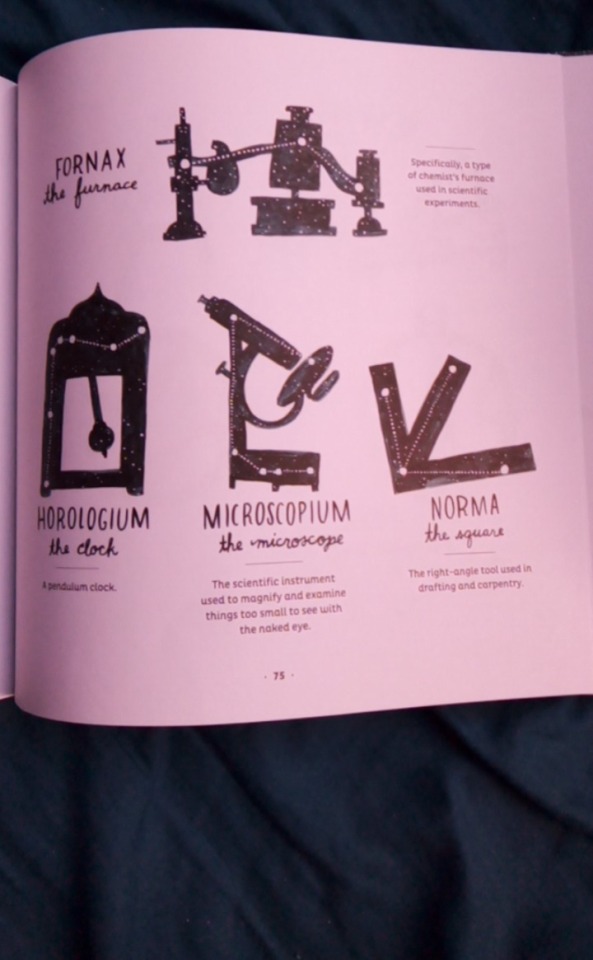
Admittedly, I finished this one a while ago and just forgot to post it, but that doesn't change the fact that it is interesting
I initially picked it up because most astronomy books are plain confusing, to me- they're too busy, and it's just not something I can concentrate on. But Oseid focusses on one constellation at a time, a couple of sentences about it, and roughly where in the sky some of the major constellations might be, all accompanied with relatively simple illustrations to help you visualize the reason for the constellation's name
There are no star charts, but there is an explanation of the difference between meteors, meteoroids and meteorites, and a page on the major meteor showers
Overall, I think that if you're just looking to get into stargazing, or developing an interest in the topic, this would be a pretty good introduction for beginners
#book review#books#my thoughts#astronomy#and astrology#just a bit#mythology#both Greek and Roman#technically
1 note
·
View note
Text
How many 'city killer' asteroids narrowly miss Earth each year?
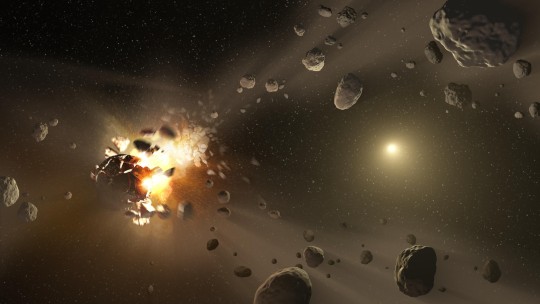
Asteroids are chunks of rock left over from the formation of our Solar System. Approximately half a billion asteroids with sizes greater than four metres in diameter orbit the Sun, travelling through our Solar System at speeds up to about 30 kilometres per second – about the same speed as Earth. Asteroids are certainly good at capturing the public imagination. This follows many Hollywood movies imagining the destruction they could cause if a big one hits Earth. Almost every week we see online headlines describing asteroids the size of a "bus", "truck", "vending machine", "half the size of a giraffe" or indeed a whole giraffe. We have also had headlines warning of "city killer", "planet killer" and "God of Chaos" asteroids. Of course, the threats asteroids pose are real. Famously, about 65 million years ago, life on Earth was brought to its knees by what was likely the impact of a big asteroid, killing off most dinosaurs. Even a four-metre object (half a giraffe, say) travelling at a relative speed of up to 60 kilometres per second is going to pack a punch. But beyond the media labels, what are the risks, by the numbers? How many asteroids hit Earth and how many can we expect to zip past us? What is the threat of a direct hit? In terms of asteroids hitting Earth, and their impact, the graphic below from NASA summarises the general risks. There are far more small asteroids than large asteroids, and small asteroids cause much less damage than large asteroids. Asteroid statistics and the threats posed by asteroids of different sizes. NEOs are near-Earth objects, any small body in the Solar System whose orbit brings it close to our planet. (Image credit: NASA) So, Earth experiences frequent but low-impact collisions with small asteroids, and rare but high-impact collisions with big asteroids. In most cases, the smallest asteroids largely break up when they hit Earth’s atmosphere, and don’t even make it down to the surface. When a small asteroid (or meteoroid, an object smaller than an asteroid) hits Earth’s atmosphere, it produces a spectacular “fireball” – a very long-lasting and bright version of a shooting star, or meteor. If any surviving bits of the object hit the ground, they are called meteorites. Most of the object burns up in the atmosphere. How many asteroids fly right past Earth? A very simplified calculation gives you a sense for how many asteroids you might expect to come close to our planet. The numbers in the graphic above estimate how many asteroids could hit Earth every year. Now, let’s take the case of four-metre asteroids. Once per year, on average, a four-metre asteroid will intersect the surface of Earth. If you doubled that surface area, you’d get two per year. Earth’s radius is 6,400km. A sphere with twice the surface area has a radius of 9,000km. So, approximately once per year, a four-metre asteroid will come within 2,600km of the surface of Earth – the difference between 9,000km and 6,400km. Double the surface area again and you could expect two per year within 6,400km of Earth’s surface, and so on. This tallies pretty well with recent records of close approaches. Related: 'Potentially hazardous' 600-foot asteroid detected near Earth after a year of hiding in plain sight RELATED STORIES —Could an asteroid destroy Earth? —Largest asteroid ever to hit Earth was twice as big as the rock that killed off the dinosaurs —Dinosaur-killing asteroid did not trigger a long 'nuclear winter' after all A few thousand kilometres is a pretty big distance for objects a handful of metres in size, but most of the asteroids covered in the media are passing at much, much larger distances. Astronomers consider anything passing closer than the Moon – approximately 300,000 km – to be a “close approach”. “Close” for an astronomer is not generally what a member of the public would call “close”. In 2022 there were 126 close approaches, and in 2023 we’ve had 50 so far. Now, consider really big asteroids, bigger than one kilometre in diameter. The same highly simplified logic as above can be applied. For every such impact that could threaten civilisation, occurring once every half a million years or so, we could expect thousands of near misses (closer than the Moon) in the same period of time. Such an event will occur in 2029, when asteroid 153814 (2001 WN5) will pass 248,700km from Earth. How do we assess threats and what can we do about it? Approximately 95% of asteroids of size greater than one kilometre are estimated to have already been discovered, and the skies are constantly being searched for the remaining 5%. When a new one is found, astronomers take extensive observations to assess any threat to Earth. The Torino Scale categorises predicted threats up to 100 years into the future, the scale being from 0 (no hazard) to 10 (certain collision with big object). Currently, all known objects have a rating of zero. No known object to date has had a rating above 4 (a close encounter, meriting attention by astronomers). Table showing the Torino Impact Hazard Scale. (Image credit: NASA) So, rather than hearing about giraffes, vending machines, or trucks, what we really want to know from the media is the rating an asteroid has on the Torino Scale. Finally, technology has advanced to the point we have a chance to do something if we ever do face a big number on the Torino Scale. Recently, the DART mission collided a spacecraft into an asteroid, changing its trajectory. In the future, it is plausible that such an action, with enough lead time, could help to protect Earth from collision. This article is republished from The Conversation under a Creative Commons license. Read the original article. Read the full article
0 notes
Text
Difference between meteoroid and meteorite

… If a meteoroid enters the Earth's atmosphere, it's called a meteor, or shooting star. Most meteoroids are small, the size of pebbles or dust from a comet's tail, but they can also be quite large. What is meteoroid short answer?Ī meteoroid is a small space rock moving through a solar system. Meteorites are the broken meteoroids that land on the earth. Meteoroids break down in the earth's atmosphere which results in the flash of light known meteors. What is the difference between meteoroids and meteorites Class 6? … They get heated up due to the friction of the atmosphere. Some meteoroids enter the Earth's atmosphere with a great velocity. They are usually made up of dust, ice particles and gases. Meteoroids are small rock pieces that revolve around the Sun. What is the difference between meteors and meteorites Class 8? … Other meteoroids are the debris that comets shed as they travel through space. Meteoroids, especially the tiny particles called micrometeoroids, are extremely common throughout the solar system. Meteoroids are lumps of rock or iron that orbit the sun, just as planets, asteroids, and comets do. What is the difference between a meteoroid and a meteor apex?Ī small body starts its life as a meteoroid floating through space between the planets until it makes a bright streak of light in Earth's atmosphere as a meteor and then, if it isn't consumed by frictional heating, finally lands on the ground as a meteorite. A meteor is what happens when a small piece of an asteroid or comet, called a meteoroid, burns up upon entering Earth's atmosphere. … An asteroid is a small rocky object that orbits the Sun. When many meteors occur in a close time frame in the same part of the sky it is called a meteor shower. A small percentage of meteoroids fly on a path that goes into the Earth’s atmosphere and then back out again, they are known as Earth grazing fireballs. What is the difference between meteoroids meteors and asteroids?Īn asteroid is a small rocky object that orbits the Sun. Meteors are easier to see during the lower light conditions of night. A meteorite refers to a meteoroid after it impacts the Earth's surface. The rule of thumb is that anything smaller than a kilometer is termed as a meteoroid, while anything bigger is an asteroid. The larger meteoroids are often termed as asteroids. The size of a meteoroid can range from the size of a grain of sand to a boulder sized particle weighing 220 lbs (100 kgs). What is the difference between a meteor meteoroid and meteorite quizlet?Ī meteor is the light streak made by a meteoroid as it streaks through the atmosphere, also called a shooting star. Rarely, some of the meteoroids that enter earths atmosphere may not get burnt completely and the remaining piece will land on earths. A meteoroid is any debris in the Solar System. When a meteoroid survives a trip through the atmosphere and hits the ground, it's called a meteorite. Think of them as “space rocks." When meteoroids enter Earth's atmosphere (or that of another planet, like Mars) at high speed and burn up, the fireballs or “shooting stars” are called meteors.

0 notes
Text

The extent of my brain power at the moment
#polly rambles#shool#this is just all i could write before i had to check my noted#*notes#because i can never remember the difference between meteorite and a meteoroid and a meteor#send help
1 note
·
View note
Text
The difference between asteroids, meteorites and meteors. Enjoy!
In simplest terms here are the definitions:
Asteroid: a large rocky body in space, in orbit around the Sun.
Meteoroid: much smaller rocks or particles in orbit around the Sun.
Meteor: If a meteoroid enters the Earth's atmosphere and vaporizes, it becomes a meteor, which is often called a shooting star.
Meteorite: If a small asteroid or large meteoroid survives its fiery passage through the Earth's atmosphere and lands on Earth's surface, it is then called a meteorite.
Asteroids
Most asteroids in our solar system are found in the main asteroid belt, a region between Mars and Jupiter. But they can also hang out in other locations around the solar system. For example, some asteroids orbit the Sun in a path that takes them near Earth.
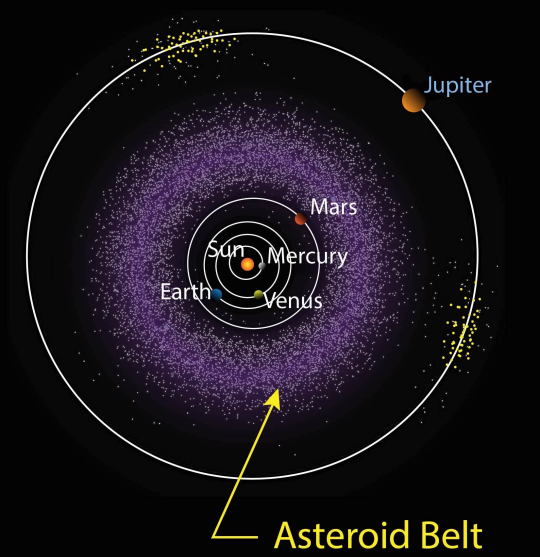
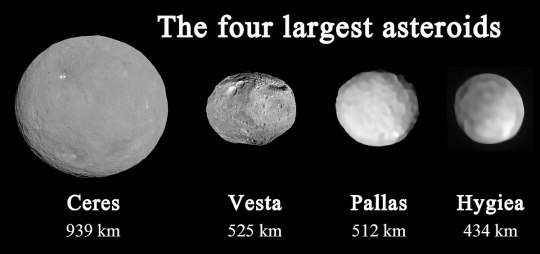
Meteoroids
Space debris smaller than an asteroid are called meteoroids. A meteoroid is a piece of interplanetary matter that is smaller than an asteroid and frequently are only millimeters in size. Most meteoroids that enter the Earth's atmosphere are so small that they vaporize completely and never reach the planet's surface. When they burn up during their descent, they create a beautiful trail of light known as a meteor, sometimes called a shooting star.

Meteorite
If any part of a meteoroid survives the fall through the atmosphere and lands on Earth, it is called a meteorite. Although the vast majority of meteorites are very small, their size can range from about a fraction of a gram (the size of a pebble) to 100 kilograms (220 lbs) or more
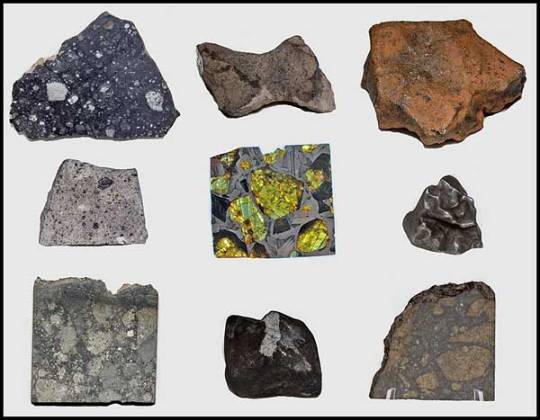
Summary
In short, the difference between asteroids and meteors all comes down to a question of location. Asteroids are always found in space. Once it enters an atmosphere, it becomes a meteor, and then a meteorite after it hits the ground. Each are made of the same basic materials – minerals and rock – and each originated in space. The main difference is where they are when they are being observed.
#astronomy#hubble#nightsky#constellations#solar system#science#nasa#asteroid#meteor shower#meteorite#spaceship#astrophysics
169 notes
·
View notes